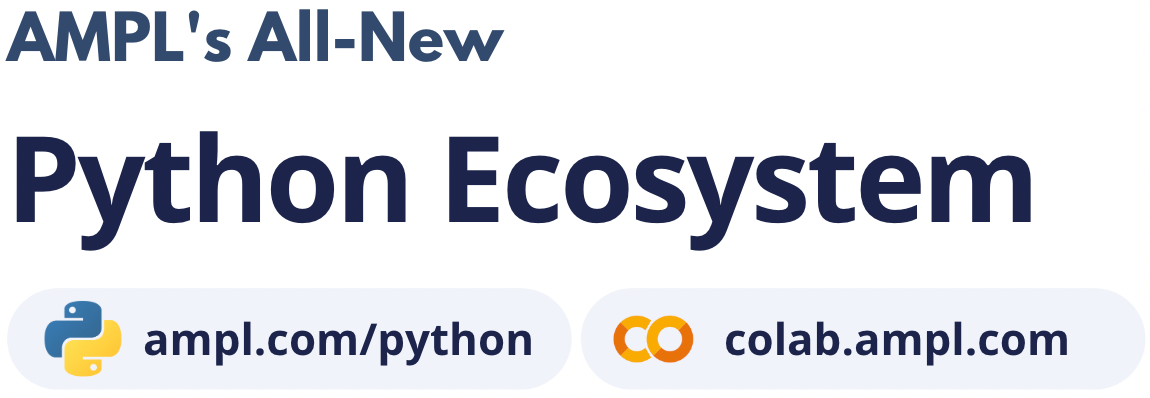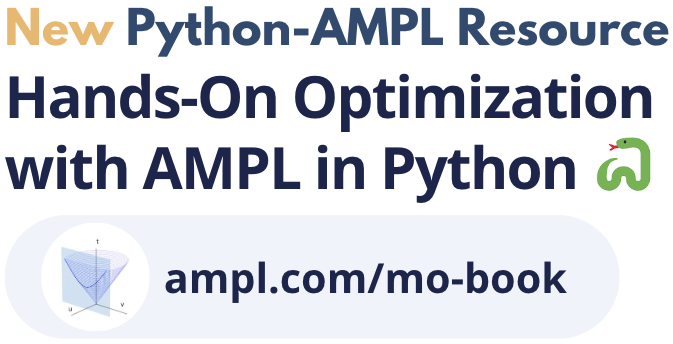Objective#
- class Objective#
Represents an AMPL objective. It can contain multiple objective instances, or can be scalar.
Generally, numerical values are available for each specific instance, which are accessible through the
function Objective.get. For scalar objective (e.g. single objective problems), direct accessors
to the values are available (see functions Objective.value or Objective.message below).
For ease of use, values for the entire algebraic entity can be accessed and assigned to MATLAB vectors using the
DataFrame object. To get the values use Objective.getValues.
get(key)#
- classmethod Objective.get(key)#
Syntax
o = get(key)
Description
o = get(key) returns the ObjectiveInstance corresponding to the specified key.
Note that the same effect can be achieved using MATLAB’s indexing operator (round brackets).
Input Arguments
keyThe key of the objective instance to look up.
Output Arguments
oThe specified objective instance.
Example
Create an indexed objective, get a reference to an instance and explore its properties
ampl.eval('var x{i in 1..2} <= i;');
ampl.eval('maximize z{i in 1..2}: x[i];');
z = ampl.getObjective('z');
instance = z.get(1);
ampl.solve;
instance.value
instance.result
instance.message
gives:
ans =
1
ans =
solved
ans =
CBC 2.8.2 optimal, objective -1
0 iterations
getValues#
- classmethod Objective.getValues()#
Syntax
df = getValues()
df = getValues(suffixes)
Description
These functions return a dataframe with all the specified suffixes of the objective, decoupled from the underlying AMPL entity.
To gain access to the data, see DataFrame.
o.getValues() gets the AMPL value (equivalent to the suffix val)
o.getValues(suffixes) allows the user to specify which suffixes to get
Input Arguments
suffixesStrings specifying which suffixes of the objective to get (see AMPL built-in suffixes).
Output Arguments
dfA dataframe containing all the specified values of the objective and its indices
Example
Create an indexed cosntraint in AMPL, then get all the values for all the suffixes for all instances in a DataFrame and display it.
ampl.eval('var x{i in 1..2} <= i;');
ampl.eval('maximize z{i in 1..2}: x[i];');
ampl.solve;
z = ampl.getObjective('z');
df = z.getValues('val', 'astatus', 'result', 'exitcode');
df
gives:
i in 1 .. 2 | value astatus result exitcode
1.0 | 1.0 in solved 0
2.0 | 2.0 in ? -1
value()#
- classmethod Objective.value()#
Syntax
v = value()
Description
v = value() Get the current value of the objective. Valid for scalar objectives only.
Output Arguments
vThe current value of the objective.
Example
Create an objective z and display its value. Then solve the problem and display the value again.
ampl.eval('var x{i in 1..2} <= i;');
ampl.eval('maximize z: sum{i in 1..2} x[i];');
z = ampl.getObjective('z')
z.value
ampl.solve
z.value
gives:
ans =
0
ans =
CBC 2.8.2 optimal, objective -3
0 iterations
ans =
3
astatus#
- classmethod Objective.astatus()#
Syntax
v = astatus
Description
astatus Return the AMPL status for this objective. Valid for scalar objectives only.
Output Arguments
vThe AMPL status for this objective.
Example
Create an objective z and display its status. Then solve the problem and display it again.
ampl.eval('var x{i in 1..2} <= i;');
ampl.eval('maximize z: sum{i in 1..2} x[i];');
z = ampl.getObjective('z')
z.astatus
ampl.solve;
z.astatus
gives:
ans =
in
ans =
in
exitcode#
- classmethod Objective.exitcode()#
Syntax
v = exitcode
Description
exitcode Get exit code returned by solver after most recent solve with this objective. Valid for scalar objectives only.
Output Arguments
vThe exit code returned by solver after most recent solve with this objective.
Example
Create an objective z and display its exitcode. Then solve the problem and display it again.
ampl.eval('var x{i in 1..2} <= i;');
ampl.eval('maximize z: sum{i in 1..2} x[i];');
z = ampl.getObjective('z')
z.exitcode
ampl.solve;
z.exitcode
gives:
ans =
-1
ans =
0
message#
- classmethod Objective.message()#
Syntax
v = message
Description
message Get the result message returned by solver after most recent solve with this objective. Valid for scalar objectives only.
Output Arguments
vThe result message returned by solver after the most recent solve with this objective
Example
Create an objective z and display its message. Then solve the problem and display it again.
ampl.eval('var x{i in 1..2} <= i;');
ampl.eval('maximize z: sum{i in 1..2} x[i];');
z = ampl.getObjective('z')
z.message
ampl.solve;
z.message
gives:
ans =
?
ans =
CBC 2.8.2 optimal, objective -3
0 iterations
result#
- classmethod Objective.result()#
Syntax
v = result
Description
result Get the result string returned by solver after most recent solve with this objective. Valid for scalar objectives only.
Output Arguments
vThe result string returned by solver after most recent solve with this objective.
Example
Create an objective z and display its result string. Then solve the problem and display it again.
ampl.eval('var x{i in 1..2} <= i;');
ampl.eval('maximize z: sum{i in 1..2} x[i];');
z = ampl.getObjective('z')
z.result
ampl.solve;
z.result
gives:
ans =
?
ans =
solved


